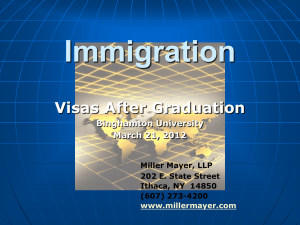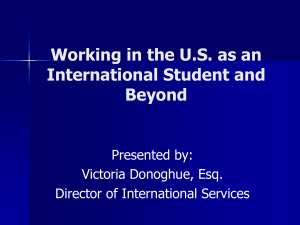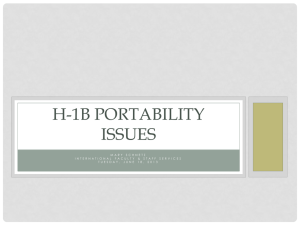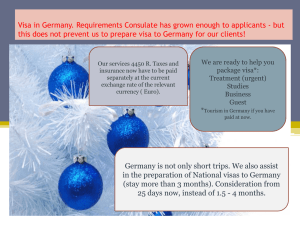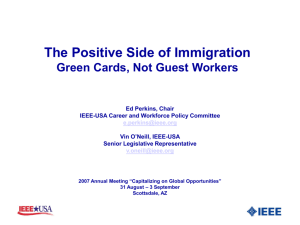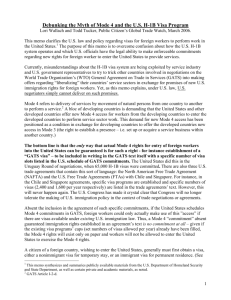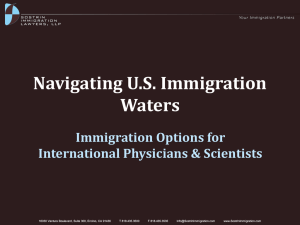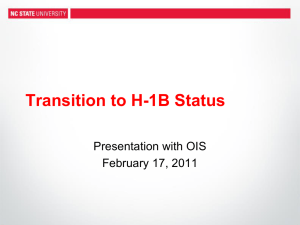Visas After Graduation - Cornell Institute for Public Affairs
advertisement
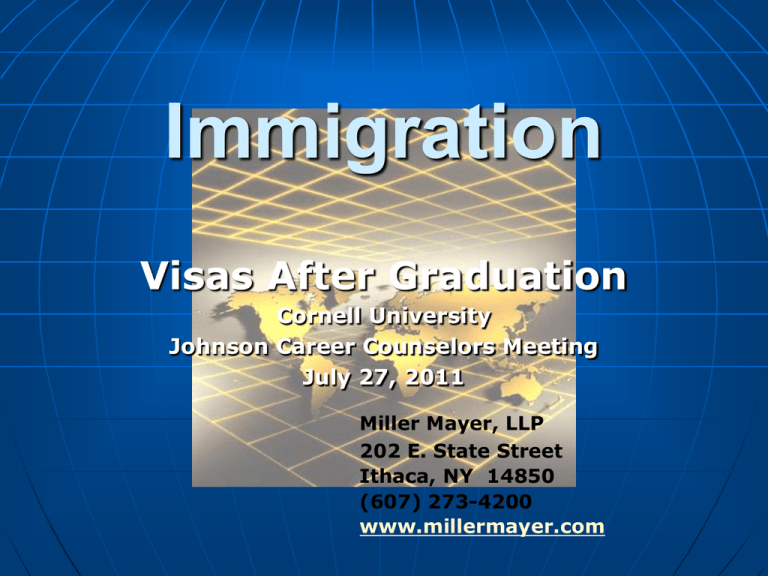
Immigration Visas After Graduation Cornell University Johnson Career Counselors Meeting July 27, 2011 Miller Mayer, LLP 202 E. State Street Ithaca, NY 14850 (607) 273-4200 www.millermayer.com H-1B Nonimmigrant Visas (NIV) Employer sponsored for up to 6 years in a “specialty occupation” 3 Requirements: • Job must require a Bachelor’s degree or higher in specific field • Beneficiary must have at least the relevant Bachelor’s degree or equivalent • Employer must pay the prevailing wage Procedure File Labor Condition Application (LCA) -Employer must pay prevailing wage; no adverse work conditions for US workers File H-1B petition (Form I-129) Overall processing time frame: • 3-4 months normally • Premium processing possibility: 2 weeks Advantages of H-1B: Duration: • 6 year maximum • 1 year stay outside U.S. refreshes 6 yrs • additional H extensions if green card started by end of 5th year Time to work toward green card No advertising or test of the U.S. labor market – but new large employer restrictions -- and new ITAR attestations H-1B portability when change employers Disadvantages of H-1B: Tied to one employer Not flexible like F-1 Optional Practical Training Paperwork, cost and delay October 1st start date + cap race Fees: $825 - $3,550 filing fee $ 2,500 approx. legal fee What is the H-1B “cap”? 65,000 per fiscal year Of 65,000, 6,800 carved out for Chile and Singapore Separate 20,000 for graduates with U.S. master’s degree or higher Race for H cap visas Quota year: October 1 to September 30 Apply Earliest: April 1 (6 months before) Past years’ H-1B quota filled: August 10, 2005 (FY 2006) May 26, 2006 (FY 2007) April 3, 2007 (FY 2008) April 7, 2008 (FY 2009) December 21, 2009 (FY 2010) January 26, 2011 (FY 2011) If needed, USCIS conducts “lottery” to select cases to be considered for H-1B approval 20,000 U.S. Master’s Exemption Defining receipt of degree “complete requirements for degree” Accredited U.S. institutions All advanced degrees included Master’s cases considered under both caps H-1B Cap Exemptions College/university employees Related or affiliated nonprofit entities Nonprofit research organizations Government research organizations Prior cap H-1B holders J-1 shortage area waivered doctors Moving from ‘Exempt’ to ‘Cap Subject’ Employer Makes you subject to the cap Concurrent employment: consider part-time with each job Pre-October 1 portability Changing jobs between April 1 and October 1 Career options and alternatives for MPAs Government jobs Entrepreneurial jobs Small town and academic jobs Overseas jobs Lower expectations of employment in the United States MPA prep for H-1B competition Internships, get to know employers early Land jobs early File by April 1st, in Masters or Bachelors cap ‘completed all degree requirements’ Obtain Registrar’s letter/degree early Cap H alternatives: non-cap H Not-for-profit, university affiliated University Government research Not-for-profit research File any time during year No quota and lower government filing fees Cap H alternatives: Accelerate Green Card filing? Enter Diversity Visa lottery (55,000 randomly selected annually) Make concurrent I-140 and I-485 filing, if priority date current Options for concurrent filing: NIW (national interest), EB-1-1 (extraordinary ability), EB-1-2 (outstanding professor or researcher) Overseas work option: EB-1-3 (multinational manager) H-1B Conclusion H-1B visas are the workhorse of the temporary worker visa categories, but are complex and must be done correctly to avoid immigration or Labor Department violations. Limited supply makes careful planning essential. Other NIVs E-3: only for Australians • • • • 2 year renewable, indefinitely 10,500 annual quota LCA only, consular filing Spouse and child work permits L-1: multinational transferee • • • • 12 months foreign employment Executive, manager, specialized knowledge Lower cost, green card, harsh adjudications Spouse work permits Treaty Nations Mexican/ Canadian (NAFTA) citizens Unlimited extensions Residence outside U.S. Up to 3 years in job offer in listed occupation Bachelor’s degree/license in that field See chapter 16 of NAFTA and 8 C.F.R. § 216.4 Common TN Occupations Accountant Architect College/university professor Computer systems analyst Engineer Graphic designer Management consultant Occupational therapist Registered nurse Scientific technician Social worker Urban planner TN Procedure for Canadians Bring to U.S. port of entry: • Proof of citizenship • Statement from employer stating the qualifications of the position • Evidence of applicant’s qualifications for that position • Filing fee Approved applicants can leave and re-enter the U.S. with their endorsed multiple entry I94 cards How Can I Become a US Permanent Resident? Family-based Employment-based Diversity Lottery Family Relationship Basis Immediate Relatives –children, spouses, or parents of US citizens (no limit per year) Unmarried sons & daughters of US citizens (23,400 visas per year) Spouses/minor children & unmarried sons and daughters of US permanent residents (114,200 visas per year) Married sons and daughters of US citizens (23,400 visas per year) Brothers and sisters of US citizens (65,000 visas per year) US citizen son or daughter sponsor must be age 21 or over Employment Basis Priority Workers (EB-1) 40,000 visas per year Extraordinary ability (self-sponsor) Outstanding professors & researchers (tenure-track position) Business executives & managers (no labor certification required) Advanced degree holders (EB-2) 40,000 visas per year Professionals with advanced degrees or exceptional ability in sciences, arts & business (labor certification required) National Interest Waiver of labor certification requirement Skilled & unskilled workers (EB-3) 40,000 visas per year Skilled workers in short supply Professionals with bachelor’s degree Unskilled workers in short supply (all require labor certification) Special Immigrants (EB-4) 10,000 visas per year Religious workers; certain US govt. employees; Panama Canal employees; plus certain dependent juveniles Investors (EB-5) 10,000 visas per year Must invest between $500,000 and $1 million Must create at least 10 full-time jobs Most Common Way to Get an Employment-Based Green Card (for EB-2, EB-3) PERM (DOL) I-140 Immigrant Visa Petition (USCIS) Adjustment of Status AOS (USCIS) Consular Processing Overseas (DOS) PERM Labor Certification A certification from the Department of Labor that a particular position at a particular company is “open” because no qualified U.S. workers are available Employer must complete 5 kinds of recruitment, show ability to pay wage and prepare audit file Electronic filing with US DOL Upon certification, must file I-140 within 180 days Final step: may have to wait for some EB-2, EB-3s I-140 Green Card Petitions (without PERM Labor Certification) Three types of EB-1 priority workers: 1. EB-1-1 Extraordinary ability aliens 2. EB-1-2 Outstanding professors and researchers 3. EB-1-3 Multinational executives and managers EB-2 (Advanced degrees, Exceptional ability) with “national interest” waiver Green Card Processing Backlogs “Priority date” is “current” EB-3 category and India and China in EB-2 category: It could take five years or longer to get an immigrant visa, even if you start today! See our website for more information Contact Congress about visa delay Sources of Information on Immigration Law Citizenship & Immigration Services – – – – – Statutes & regulations Forms Procedures and instructions Contact information Processing times Sources of Information on Immigration Law U.S. Department of State – – – – – – Links to embassies & consulates worldwide Application procedures and consulate closings Wardens messages and travel advisories Public announcements Derivative citizenship and renunciation Visa Bulletin regarding priority dates Issues of Relevance for CU MPA students: Past student experiences in applying for OPT, H, and PR Loopholes to be aware of H process for the employer vs. foreign student Employer reluctance in hiring foreign students Technical degrees an advantage? F-1 and J-1 work authorization Curricular Practical Training (CPT) – Internship or work experience while studying for a degree OPT/Post- or Pre-Degree Permitted to work in the US for 1 year under F-1 visa FICA exempt SEVIS employer registration Unemployment > 90 days is a problem Volunteering can help Travel can be difficult, extend for 17 months, total 29 months E-verified employer On campus Cap H alternatives: OPT and more OPT 12 months F, 18 and 36 months J STEM EVerify 17 month extensions (29 months minimum and 2 tries at H cap race) EVerify’s fate and lobbying to expand STEM exception? OPT Timeline & Cap Gap Extension Apply 2/27/11 60-day grace period Program end date 5/27/11 7/26/11 Apply for H 4/1/2012 EAD expires 7/23/2012 You choose your OPT start date Example: 7/24/11 Apply up to 120 days before your chosen start date -- 90 days before program end date and up to 60 days after. 12 months OPT plus cap gap extension 10/1/2012 Parting Thoughts Realistic assessment is important Planning ahead is key Get to know employers soon Think of alternatives and creative employment options Need help with immigration matters? How to choose an immigration attorney Interested in an immigration consultation? Sign up for a free monthly immigration newsletter Contact: Miller Mayer, LLP 202 E. State Street, Suite 700 Ithaca, NY 14850 (607) 273-4200 info@millermayer.com Questions?
